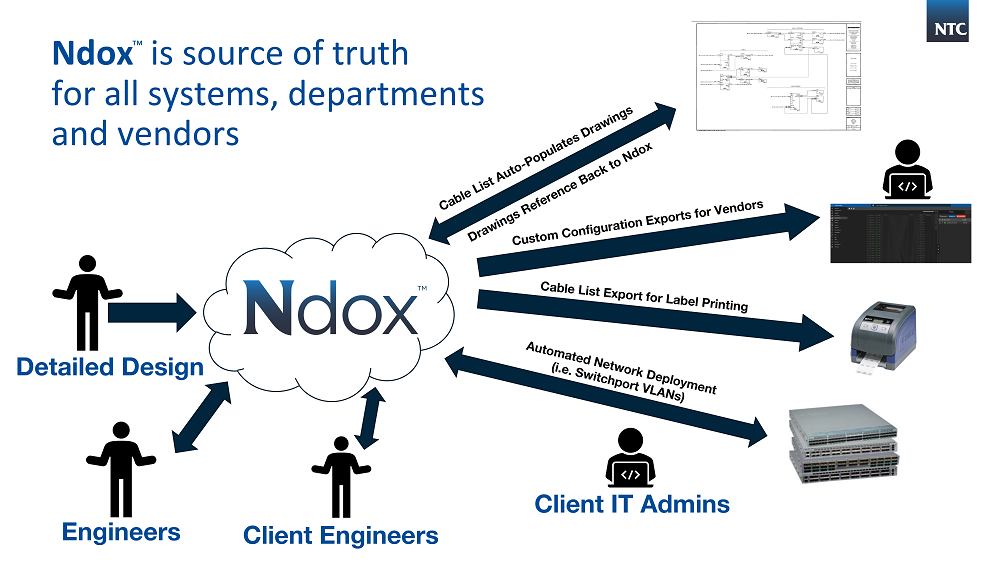Designing, documenting, and configuring technology infrastructure at large media facilities has become increasingly challenging in recent years. As technology centers and production facilities move toward cloud, virtualization, and IP technology, traditional methods of documenting and building systems and networks with spreadsheets, drawings, and hardware configuration by hand have become untenable. For a modern facility—composed of hundreds of pieces of hardware, tens of thousands of IP addresses, and miles of cable—documenting connections in a spreadsheet format simply does not scale.
National TeleConsultants (NTC) is a media and broadcast systems specialist that has designed and integrated major facilities for FOX, The Walt Disney Company, DIRECTV, and many others. With the goal of improving design process, accuracy, and efficiency, they have developed a solution to address the intricacies of documenting large-scale, hybrid media IP infrastructures: Ndox. Ndox is a robust, browser-based solution that provides a centralized repository for all aspects of system design. What sets Ndox apart is that it goes well beyond the physical level and includes logical design elements such as virtual machine resources, IP addresses, and networking configuration. Ndox serves as the “trusted repository” for information throughout the system and has the powerful ability to directly drive downstream network configuration processes in addition to providing the necessary physical level documentation. This integrated approach organizes all data in one place, which greatly reduces the possibility of errors and provides centralized access to users across multiple business units and disciplines.
“Ndox addresses several problems common to large media system infrastructures,” says NTC Managing Partner Eliot Graham. “In the construction and ongoing support of complex IP-based facilities, it is critical to have a deep understanding of how the system works, not just in terms of physical connections but more importantly from a logical standpoint. From an operational point of view, Ndox serves as this source of information. Whenever a change is made, everyone has immediate access to the latest information.” Ndox is built on open-source software to address specific requirements of media system infrastructures and create a seamless user experience that unifies the previously disparate details of each sub-system.
Ndox allows engineers to aggregate all data relevant to system infrastructure, even when subsystems span multiple locations. This data is accessible to stakeholders across the organization with varying layers of access security to safeguard against unauthorized changes. This makes it easy to identify misconfigured ports, incorrect cabling, and similar issues. Ndox allows real-time comparison of the desired system state with the current state by integrating with network infrastructure. If there are inconsistencies in the real world, they are immediately identified and surfaced to engineers to quickly resolve issues.
“The industry has changed a lot in terms of how things are designed, built, documented, and run,” says NTC Managing Partner Peter Adamiak. “We’ve moved beyond a world based solely on physical connectivity. In the past, you could look at drawings and understand how a system works. Today, logical and virtual designs are the norm and engineers require a new design and documentation approach. Ndox is NTC’s solution to this for our projects and clients.”
Most recently, NTC employed Ndox in designing and installing infrastructure for a new, very large-scale media center built for a major domestic media enterprise. This media center was created to manage and distribute programming to hundreds of affiliated television stations and more than 800 distribution partners nationwide. Its technical systems include a SMPTE ST 2110 IP core, hybrid-cloud architecture, software-based media processing, and support for new media standards such 4K, UHD, and HDR.
Ndox proved itself as an integral part of NTC’s design and integration process for this new media center. With Ndox, NTC’s engineers were able to meticulously plan and organize IP addresses, networks and subnetworks, equipment layouts, devices, circuit connections, virtual machines, and other details easily and accurately, with everyone working in a shared database. This information was then shared with the integration team who could readily access the latest design information using portable devices (iPhones, iPads, etc.) from anywhere in the facility.
Ndox made the design and installation process more efficient and less prone to error. “Assembling the building blocks and defining physical connections in Ndox was seamless,” says Senior Engineer Lukas Odhner. “It also allowed us to describe the logical layer by assigning IP addresses, port channels, VLANs, and so on. All that information was immediately available to the people who were building it out. It’s been a very effective way to show how things were intended to connect and interact.”
Odhner adds that the platform includes highly detailed visualizations of racks and equipment for easy reference. “A technician can view each device, its model number, and pertinent information, and quickly determine where it is supposed be installed,” he explains. “No need to ask an engineer, ‘What is this?’ and ‘Where does it go?’”
As an on-going operational tool, Ndox will help keep network systems at the new media center facility functioning properly by ensuring that the documentation matches the physical and logical reality. Odhner notes that one of the drawbacks to using spreadsheets for network documentation is that changes to the network are not automatically reflected. “If you're keeping a list of VLANs in Excel and you change something on a switch manually without updating the spreadsheet, you have created a discrepancy,” he says. “With Ndox, the documentation drives the configuration; this automated deployment approach avoids these inconsistencies and ensures the network and its documentation stay in sync.”
In addition to new installations, Ndox can also be used to bring coherence and predictability to existing technical environments. “For facilities that are already built using traditional documentation, Ndox can be used to capture everything as it currently is and provide a roadmap for bringing systems into a desired future state,” Odhner explains.
Adamiak says that Ndox is an important innovation and one that should be viewed as a critical component in a broader solution to the ongoing management of media system infrastructures. Today’s hybrid networks are fundamentally different from the purely physical networks of the past. Managing them efficiently requires different tools and a different mindset. “One thing that NTC brings to the table is a thoughtful approach to best practices,” he explains. “We have many years of experience with infrastructures of different types and scales and understand the nuances and how decisions made in configuration impact operations down the line. No two facilities are alike and no one strategy works for all. When we begin a new project, we start by learning all we can about the customer and their existing requirements. We have to deeply understand their needs before we begin the technical work of designing systems that will help them meet their goals into the future.”
About National TeleConsultants (NTC)
Founded in 1981, National TeleConsultants is a leading systems solution company that provides strategic technology consulting, engineering design, software development, and systems integration services to the global media and entertainment industry. NTC’s clients include multichannel video programming distributors, broadcast and cable networks, film and television production studios, and digital media companies. The company is headquartered in Glendale, California.
For more information about NTC please visit us at www.ntc.com or contact us. (https://www.ntc.com/contact/).


